Jay Clark Enterprises restores a little fun in motocross by restoring a 2006 Suzuki RM125.
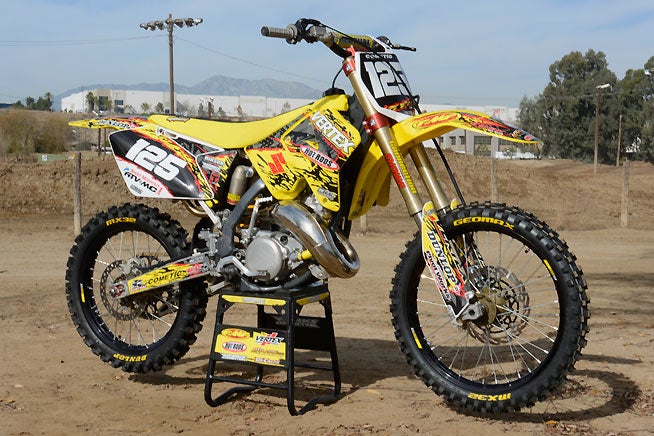
It’s a damn shame to think about all of the unloved 125cc two-strokes that are probably languishing in moto enthusiasts’ garages and backyards. At one time, tiddlers were the ultimate two-wheeled right of passage in the sport of motocross, the first big-wheeled bike on which junior heroes hit the jumps and took their lumps before graduating on to 250cc or Open-class two-strokes. The 125s were excellent at teaching momentum and energy conservation, which was dictated by their light-switch narrow powerbands.
Then along came the Yamaha YZ400F, and shortly thereafter came the YZ250F, both bikes changing the climate of planet motocross. With the low-end torque of the 250cc thumpers, riders no longer had to learn how to shift smoothly and keep an attendant finger on the clutch lever in order to milk every last rpm out of a corner before a big jump. Motocross became more of a point-and-shoot proposition.
But even though four-strokes are the standard–and, yes, a good 250F pilot will have an advantage over a similarly skilled 125cc pilot in most cases—those abandoned baby two-smokers still pack more fun per eighth-liter than any other dirtbike, and with the maintenance intervals of modern four-strokes practically matching their two-stroke siblings, fixing up an old 125 can be economical as well as fun.
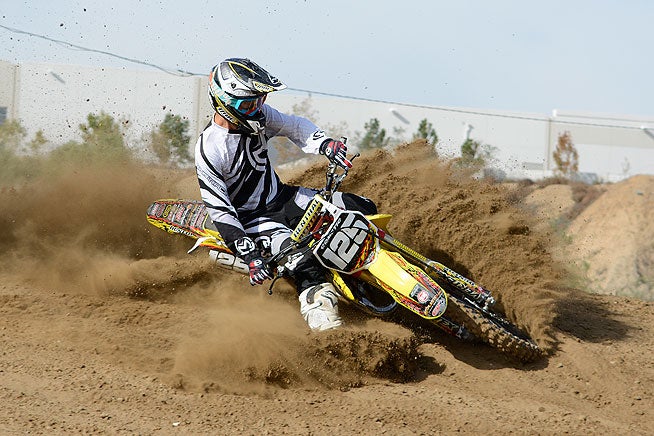
Fortunately for us, our fearless project guru, Jay Clark of Jay Clark Enterprises, is an old-school brother who knows this to be true. When Clark was looking to build a bike to transition from an 85cc two-stroke to the big bikes, he wanted to make sure that the boy honed his skills the right way. That meant not skipping a 125 en route to an easier-to-ride 250F. The little yellow beauty you see here is the result of Clark’s vision.
This 2006 Suzuki RM125 was purchased off Craigslist for a paltry $600. Too bad it turned out to be only worth about that much once Clark dove inside the motor.
“That might sound tremendous on the surface however, if you add in the approximately $1500 to get parts for the engine and repair the suspension it is not as tremendous,” Clark said. “The bike was blown up. The cylinder was ruined and the crank was in need of a rebuild as well. Sometimes even a free bike can be worth just that (nothing).”
Clark cautions that when you are hunting for a bargain two-stroke to be sure that the cases, cylinder and head are in good condition.
“These parts cost way too much stock, in most cases, to consider replacing,” Clark said.
Clark’s RM required engine full rebuild. Doing the work himself saved a lot of money, but the cylinder needed to be completely reconditioned, so Clark shipped it to the boys at Millennium Technologies to be completely refurbished and finished off with Millennium Technologies’ awesome Nikasil plating. We intend to explain this entire process to you in an upcoming tech story, but suffice it to say that once Millennium Technologies gets through with a salvageable barrel, it is as good as new—and maybe even better.
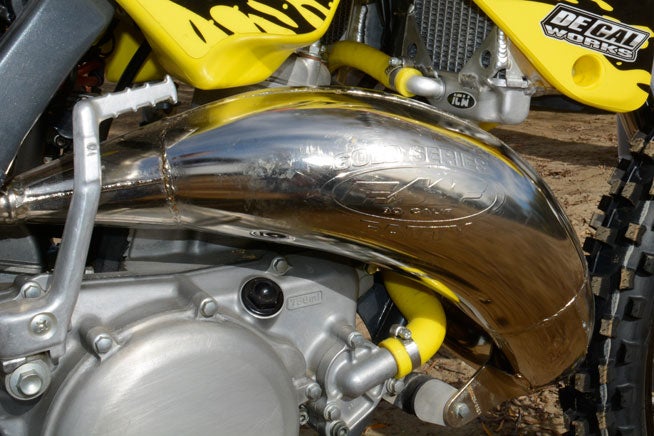
Since 125s are already on the short-end of the scale when it comes to service intervals, Clark says that the main goal with the motor was durability; it needed to run well on pump gas and be reliable enough for a beginner-level rider to get a lot of hours of use out of it. This was accomplished via a full rebuild using a Hot Rods bottom-end kit, which comes complete with a new crankshaft, main bearing seal kit and complete engine gasket kit. Since this wasn’t going to be an exper-level, high-compression race motor, Clark replaced the worn-out stock piston with a cast Vertex Pro Replica piston kit.
While the inside of the motor was kept stock, Clark employed some fairly common tricks to liven up the RM’s power character. These included installing moto Tassinari V-Force Reed Cage and FMF Racing Fatty exhaust (with the chrome finish for a little extra visual snap) and Shorty silencer to improve the ingestion and expulsion of fuel and air. Since 125s often require that the clutch be fanned multiple times per lap, Clark wanted to make sure that the RM had a fresh one, so he ditched the stock fiber plates, steel plates and springs in favor of brand new ones from Hinson Clutch Components.
The RM’s carburetor, like many that have sat for long periods of time, was very dirty, so it required a complete cleaning and rebuild with a new needle/seat set up and a full cleaning. The stock jetting is slightly different from stock. Clark went with a 370 main jet and a 42.5 pilot jet. He turned the air screw out two turns and set the stock needle jet to the second clip position. Presto! Done! The only other intake change was to stuff a UniFilter two-stage filter in the RM’s airbox to ensure clean supply of air.
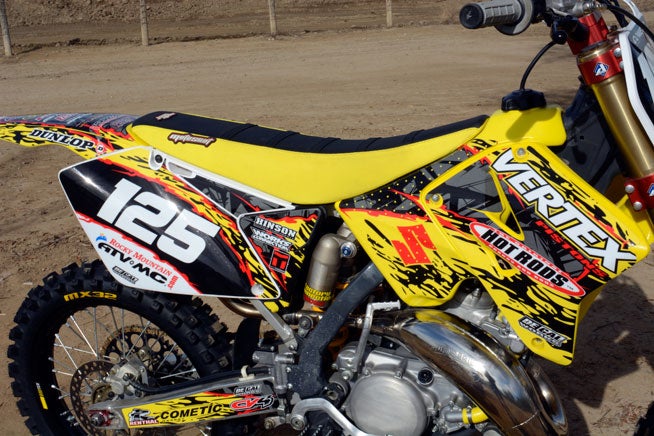
Turning his attention to the chassis, Clark enlisted San Diego Powder Coating to buff out the RM’s engine cases and powder coat its frame to give the bike a fresh new look to the entire bike.
Rather than go the entire valving route, the stock suspension was rebuilt with fresh Pivot Works bearings, seals and oil. Clark worked with the capable folks at Factory Connection to get the suspension back to good as new.
After that, Clark did what he usually does, which is to enlist a gaggle of great products from the companies he works with. Clark chose Renthal for its 997 Twin Wall handlebars and Dual Compound grips. The bars are bolted to an Applied Racing triple clamp. Renthal also supplied the chain along with the front and rear sprockets. The all-new fenders and number plates are from MXPlastic.com are adorned with a DeCal Works Semi-Custom graphics kit and pre-printed numberplate backrounds. The stock seat foam is topped with a Custom Cool seat cover is from MotoSeat.
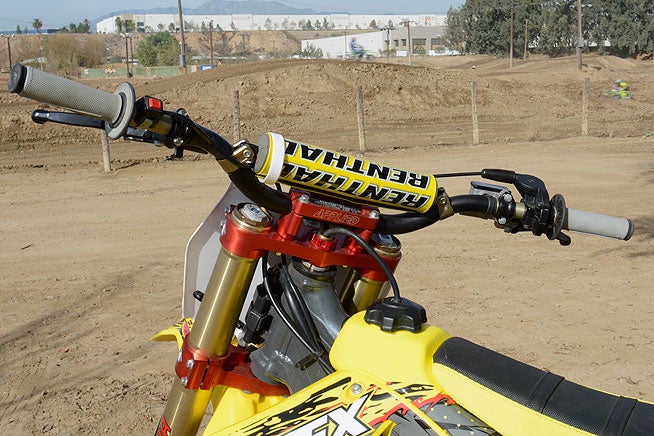
There are also dozens of detail bits from Works Connection and Tusk, including Works Connection radiator braces, brake caps, oil filler plug and Elite clutch perch, and Tusk’s high-pressure radiator cap and chain blocks.
Traction under acceleration and during braking are as critical on a 125 as they are on any other size machine, maybe even more. To ensure that this RM125 gets its ponies to the ground, Clark fitted the wheels with Dunlop’s awesome Geomax MX32 tires at both ends, and he made sure that the bike received a little braking performance via a MotoMaster 270mm front brake disc and a Tusk braided steel brake line. To add a little more braaap! to the rolling stock, Clark also sent the RM’s hubs to TCR Wheels in Lodi, California. TCR machine-turned and mag-coated the hubs for a trick custom appearance.
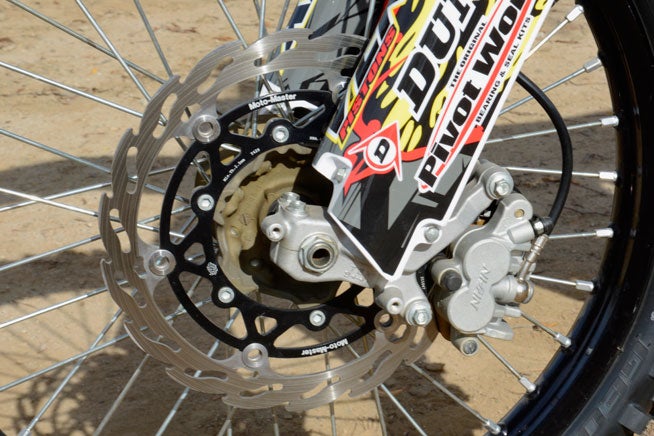
Riding Impression
Naturally, for some hard-core moto mashing impressions of Clark’s project RM125, we took the bike to Milestone MX in Riverside, California, and turned it over to DBC’s desert and motocross test pilot Ryan Abbatoye. Surprisingly enough, the “RAD one” has comparably little experience on two-stroke motocrossers, having picked up his considerable chops on four-stroke machinery. That made for an interesting dynamic as Abbatoye spent several laps looking a little like a duck out of water on the screaming RM. But, he’s a pro, and it didn’t take long before he put his head down and started to really make the little yellow zonker fly. When he returned to the pits after a simulated moto, you could see the grin through his helmet.
“I haven’t done a lot of 125 riding ever,” Abbatoye said. “The biggest thing was just getting used to the two-stroke style of power after having ridden a four-stroke for so long. You really have to rev a two-stroke, especially a 125, to get going. You can be lazy with a four-stroke because you have so much more low-end torque.”
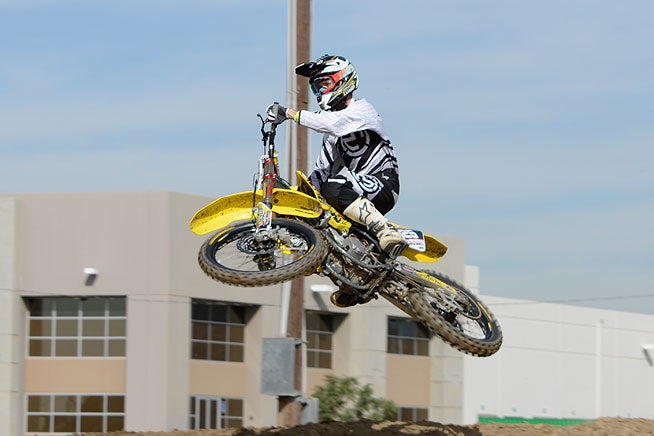
Once Abbatoye got used to shrieking the 125’s guts out, he began to cut some serious lap times, and there wasn’t a jump on the track that he couldn’t clear with ease.
“It is definitely a fun bike,” he said. “It’s light and easy to throw around, and it sounds cool! It has plenty of punch as long as you keep it in the meat of the power, which is really narrow. I think it is definitely a good bike for teaching you how to keep your momentum up through corners. It handles so lightly that you can just put it wherever you want to in a corner. The only issue I had was when I hit the biggest tabletop on the track. I couldn’t hit it all the way from the inside of the turn and clear it like I could on a four-stroke. I had stay one groove toward the outside and keep my momentum up, but when I did that I could clear it easily.”
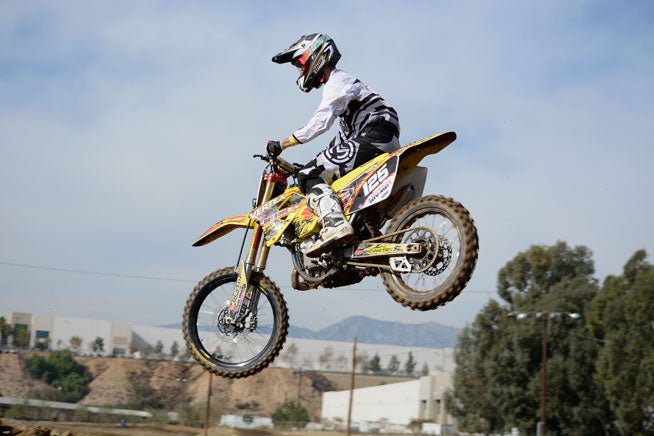
Abbatoye also noted that the stock suspension, while a little soft for his weight and skill level, was still surprisingly good, which only goes to show just how much potential there is in OEM parts that are freshly built and carefully dialed-in like the fork and shock on Clark’s bike. The suspension, combined with the inherent light weight of the 125, allowed Abbatoye to keep the RM’s throttle pinned.
“The only down side to learning to ride like that is that when you switch to a four-stroke, you won’t want to ride it like a two-stroke,” Abbatoye continued. “You don’t ride a four-stroke so revved up and keep hammering the clutch. If you do that you’re going to go through a lot of clutches and valves. A four-stroke is easier to ride, but if you learn to ride a two-stroke and learn to conserve your momentum, and then you switch to a four-stroke, you’re going to be untouchable.”
Where two-strokes still make sense, and probably always will, Abbatoye says, is during maintenance time.
“Most people don’t really read their owner’s manual,” Abbatoye said. “If they did, they probably wouldn’t believe just how many parts you have to change and just how short the service intervals are. You can rebuild an entire two-stroke motor for less than the price of a four-stroke top-end, and you can do it at the track. Rebuilding a four-stroke involves knowing cam timing and a lot of other things. If you don’t know all that stuff, you’re going to have to pay someone to do it.”
At the end of the day, Clark proved that refurbishing a 125cc two-stroke is a worthwhile exercise. It can be fun during the actual wrenching process because the machine itself isn’t very complicated, and the finished machine is a lot of fun to ride. And if you start with a better core bike than Clark did, and it can even be relatively affordable when you consider what you’d have to spend to rebuild a 250cc four-stroke with a similar number of hours on it.
And even then, you wouldn’t have a bike that can teach you a thing or two while you spend the day gleefully revving its guts out.
Rocky Mountain ATV/MC
www.rockymountainatvmc.com 800-336-5437
Hot Rods
www.rockymountainatvmc.com/Hot-Rods
Complete bottom end kit, $353.97
Vertex Pistons
www.rockymountainatvmc.com/Vertex
Pro Replica piston kit (ring, pin and clips), $99.99
Uni Filter
www.rockymountainatvmc.com/Uni-Filter
Two-Stage air filter, $25.99
Hinson Clutch Components
www.rockymountainatvmc.com/Hinson
Fibers, steels and springs clutch kit, $179.99
FMF Racing
www.rockymountainatvmc.com/FMF
Fatty exhaust (chrome), $215.99
Shorty silencer, $116.99
Moto Tassinari
www.rockymountainatvmc.com/V-Force
V-Force reed cage, $140.99
Pivot Works
www.rockymountainatvmc.com/Pivot-Works
Steering stem bearing kit, $44.99
Fork rebuild kit, $67.99
Shock rebuild kit, $80.99
Renthal
www.rockymountainatvmc.com/Renthal
Front sprocket, $20.99
Rear sprocket, $51.99
Chain, $81.99
997 Twin Wall handlebar, $95.99
Dual compound grips, $11.99
Dunlop Tire
www.rockymountainatvmc.com/Dunlop
Geomax MX 32 front 80/100-21, $77.99
Geomax MX 32 rear 100/90-19, $82.99
Works Connection
www.rockymountainatvmc.com/Works-Connection
Stand, $107.99
Radiator braces, $62.99
Brake caps, $24.99 each
Oil filler plug, $22.99
Elite clutch perch, $79.95
Tusk
www.rockymountainatvmc.com
High pressure radiator cap, $15.99
Front steel braided brake line, $44.99
Chain blocks, $19.99
Klotz Synthetic Lubricants
www.rockymountainatvmc.com/Klotz
R-50 Two-Stroke Pre-Mix, $7.99
Millennium Technologies
www.mt-llc.com 920-893-5595
Strip, re-pair damage and re-plate to stock size (call for pricing)
ICW
www.icwbikestands.com 919-795-8084
Radiator straightening (call for pricing)
MXPlastic.com
www.mxplastic.com 800-843-8244
Plastic kit, $181.77
DeCal Works
www.decalmx.com 815-784-4000
Semi-Custom Graphics kit w/pre printed number plates backgrounds, $269.90
MotoSeat
www.motoseat.com 951-258-5229
Custom Cool seat cover, $59.95
TCR Wheels
www.wheellacing.com 209-368-9800
Custom turned and mag-coated stock hubs, $350 per pair
Applied Racing
www.AppliedRace.com 800-853-0555
Triple clamp set, $189.95
San Diego Powder Coating
www.sandiegopowdercoating.com 619-956-0987
Sandblasting, powder sparkle silver with superdurable clear, and “race prep masking” (call for pricing)
Motomaster
www.moto-masterusa.com 800-749-2890
Oversized 270mm front rotor, $147
Factory Connection
www.factoryconnection.com 800-221-7560
Suspension rebuild and service (call for pricing)
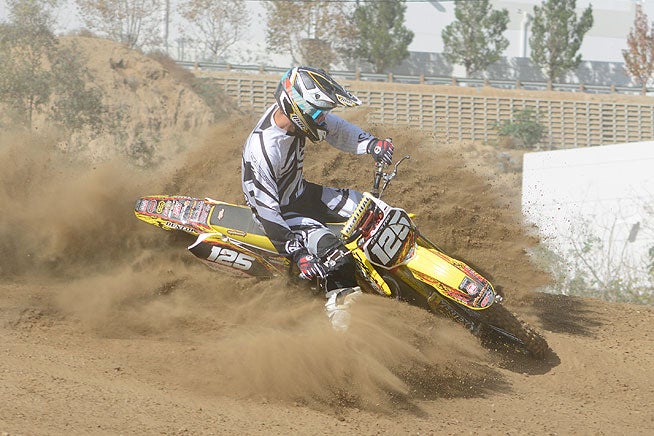
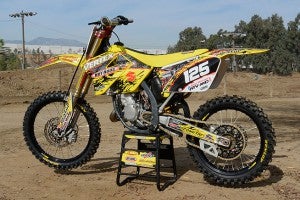
 Your Privacy Choices
Your Privacy Choices